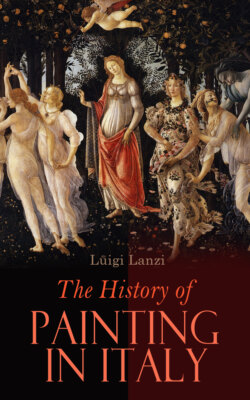The History of Painting in Italy

Реклама. ООО «ЛитРес», ИНН: 7719571260.
Оглавление
Luigi Lanzi. The History of Painting in Italy
The History of Painting in Italy
Table of Contents
VOLUME 1
Table of Contents
PREFACE
BIOGRAPHICAL NOTICE. [24]
HISTORY OF PAINTING. IN. LOWER ITALY
BOOK I
FLORENTINE SCHOOL
EPOCH I
SECT. I
FLORENTINE SCHOOL. EPOCH I
SECT. II
FLORENTINE SCHOOL. EPOCH I
SECTION III
FLORENTINE SCHOOL. EPOCH II
FLORENTINE SCHOOL. EPOCH III
FLORENTINE SCHOOL. EPOCH IV
FLORENTINE SCHOOL. EPOCH V
BOOK II
SIENESE SCHOOL
EPOCH I
SIENESE SCHOOL. EPOCH II
SIENESE SCHOOL. EPOCH III
VOLUME 2
Table of Contents
HISTORY OF PAINTING. IN. LOWER ITALY
BOOK III
ROMAN SCHOOL
ROMAN SCHOOL. EPOCH I
ROMAN SCHOOL. EPOCH II
ROMAN SCHOOL. EPOCH III
ROMAN SCHOOL. FOURTH EPOCH
ROMAN SCHOOL. FIFTH EPOCH
BOOK IV
NEAPOLITAN SCHOOL
FIRST EPOCH
NEAPOLITAN SCHOOL. SECOND EPOCH
NEAPOLITAN SCHOOL. THIRD EPOCH
NEAPOLITAN SCHOOL. FOURTH EPOCH
VOLUME 3
Table of Contents
HISTORY OF PAINTING. IN. UPPER ITALY
BOOK I
VENETIAN SCHOOL
VENETIAN SCHOOL. EPOCH I
VENETIAN SCHOOL. SECOND EPOCH
VENETIAN SCHOOL. THIRD EPOCH
VENETIAN SCHOOL. EPOCH IV
VOLUME 4
Table of Contents
HISTORY OF PAINTING. IN. UPPER ITALY
BOOK II. THE SCHOOLS OF LOMBARDY
CHAPTER I
MANTUAN SCHOOL. EPOCH I
MANTUAN SCHOOL. EPOCH II
MANTUAN SCHOOL. EPOCH III
CHAPTER II
THE MODENESE SCHOOL. EPOCH I
MODENESSE SCHOOL. EPOCH II
MODENESE SCHOOL. EPOCH III
CHAPTER III
THE SCHOOL OF PARMA. EPOCH I
SCHOOL OF PARMA. EPOCH II
SCHOOL OF PARMA. EPOCH III
CHAPTER IV
SCHOOL OF CREMONA. EPOCH I
SCHOOL OF CREMONA. EPOCH II
SCHOOL OF CREMONA. EPOCH III
SCHOOL OF CREMONA. EPOCH IV
CHAPTER V
SCHOOL OF MILAN. EPOCH I
SCHOOL OF MILAN. EPOCH II
SCHOOL OF MILAN. EPOCH III
SCHOOL OF MILAN. EPOCH IV
VOLUME 5
Table of Contents
HISTORY OF PAINTING. in. UPPER ITALY
BOOK III
BOLOGNESE SCHOOL
BOLOGNESE SCHOOL. EPOCH I
The Ancients
SCHOOL OF BOLOGNA. EPOCH II
Various styles from the time of Francia to that of the Caracci
BOLOGNESE SCHOOL. EPOCH III
The Caracci, their Scholars, and their Successors, until the time of Cignani
BOLOGNESE SCHOOL. EPOCH IV
Pasinelli, and in particular Cignani, cause a Change in the Style of Bolognese Painting. The Clementine Academy and its Members
BOOK IV
SCHOOL OF FERRARA
EPOCH I
The Ancients
SCHOOL OF FERRARA. EPOCH II
Artists of Ferrara, from the time of Alfonso I. till Alfonso II., last of the Este family in Ferrara, who emulate the best Italian styles
SCHOOL OF FERRARA. EPOCH III
The Artists of Ferrara borrow different styles from the Bolognese School.—Decline of the Art, and an Academy instituted in its support
BOOK V
GENOESE SCHOOL
EPOCH I
The Ancients
GENOESE SCHOOL. EPOCH II
Perino and his Followers
GENOESE SCHOOL. EPOCH III
The Art relapses for some time, and is re-invigorated by the Works of Paggi and some Foreigners
GENOESE SCHOOL. EPOCH IV
The Roman and Parmesan succeed to the Native Style. Establishment of an Academy
BOOK VI
THE HISTORY OF PAINTING IN PIEDMONT AND THE ADJACENT TERRITORY
EPOCH I
Dawn of the Art, and Progress to the Sixteenth Century
EPOCH II
Painters of the Seventeenth Century, and first Establishment of the Academy
EPOCH III
School of Beaumont, and Restoration of the Academy
Отрывок из книги
Luigi Lanzi
Complete Edition
.....
[41] See Signor Ab. Bettinelli, Risorgimento d' Italia negli studii, nelle arti, ne' costumi dopo il mille, p. 192.
[42] To this list of early painters might perhaps be added the name of Francesco Benani, by whom there is a whole length figure of St. Jerome holding a crucifix in his hand. It possesses all the characteristics attributed by Lanzi to this early age. Near the bottom of the picture is a label, inscribed, Franciscus Benanus, Filius Petri Ablada. The size of the picture is 2 feet 8 by 2 feet 2, on panel, covered with gypsum. The vehicle of the colours is probably prepared from eggs, which were usually employed for that purpose before the invention of painting in oil, and to which an absorbent ground of lime or gypsum seems to have been indispensable. It is surprising how well the early pictures executed in this style have preserved their colouring to the present day.
.....